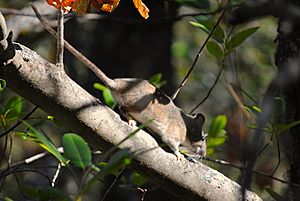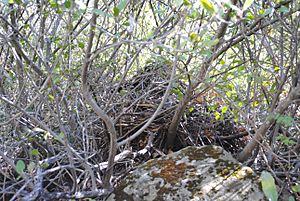Dusky-footed woodrat facts for kids
Quick facts for kids Dusky-footed woodrat |
|
|---|---|
 |
|
| Conservation status | |
| Scientific classification | |
| Genus: |
Neotoma
|
| Species: |
fuscipes
|
The dusky-footed woodrat (Neotoma fuscipes) is a type of rodent that is active at night (this is called nocturnal). People often call them "packrats" or "trade rats." They build huge, dome-shaped homes called dens, which can be several feet tall! Coyotes and other animals that hunt them try to break into these dens. But the dens are usually so big and strong that predators give up. Sometimes, these woodrats even build smaller dens in trees.
Even though these animals usually live alone, except when they are looking for a mate, their dens are often found close together. You might see groups of up to several dozen dens, forming small "communities." Dusky-footed woodrats look a bit like common rats. But they have bigger ears and eyes, softer fur, and furry tails. Another mouse, the California mouse, sometimes lives inside woodrat dens. These dens have a cozy nest and special "pantry" rooms. These pantries are used to store leaves and nuts for later meals.
Contents
Where Do Dusky-footed Woodrats Live?
You can find dusky-footed woodrats in Mexico and the United States. They live from Oregon down into the northern part of Baja California. They are found along the Pacific coast, west of the deserts and dry areas.
These woodrats like places with lots of thick bushes, like chaparral. They are often found near streams. You can also spot them in forests with juniper trees or mixed trees. They always prefer areas with plenty of plants covering the ground. In some parts of California, they can even live in rocky areas if there's enough plant cover.
What Do Dusky-footed Woodrats Eat?
Dusky-footed woodrats mostly eat plants. This means they are herbivores. However, they will also eat insects like mealworms if they find them. They enjoy eating different parts of plants, such as branches, leaves, fruits, and nuts.
Woodrats store food in their nests. A typical nest might have food from about five different kinds of plants. But they usually have one main food source. For example, they really like oak trees if they are available. While most woodrats eat many different plants, some groups specialize. This means they might prefer certain plants based on where they live. For instance, woodrats living just a kilometer apart might eat different things. One group in a juniper forest might prefer juniper, while another in a different forest might mostly eat incense cedar.
Who Hunts Dusky-footed Woodrats?
Many animals hunt dusky-footed woodrats. These include owls, coyotes, hawks, weasels, skunks, snakes, and cats. These predators, along with humans, help keep the woodrat population in balance.
How Do Dusky-footed Woodrats Behave?
Building Their Homes
Woodrats build amazing homes, called nests or dens. They build them in trees, on the ground, or on cliffs. They choose spots with thick plants or rocks for cover. These nests are shaped like cones and can be two to eight feet tall! They are made from sticks, bark, and other plant materials.
One nest can be used by many generations of woodrats. Each new family adds to the nest, making it bigger and bigger. These nests can have many different rooms. Some rooms are for storing food, others for resting, and some are nurseries for baby woodrats. They also provide protection from predators.
Woodrats sometimes build their nests in tough places. This includes thorny bushes or patches of poison oak. This makes it harder for predators to reach them. Scientists have found that dusky-footed woodrats in California do something very clever. They place California bay leaves around the edges of their nests. These leaves help keep away tiny bugs like fleas. The leaves have natural chemicals that are harmful to flea larvae (baby fleas). It's thought that woodrats learned this trick over time to protect themselves from these annoying bugs.
Images for kids
See also
 In Spanish: Rata cambalachera patas oscuras para niños
In Spanish: Rata cambalachera patas oscuras para niños





